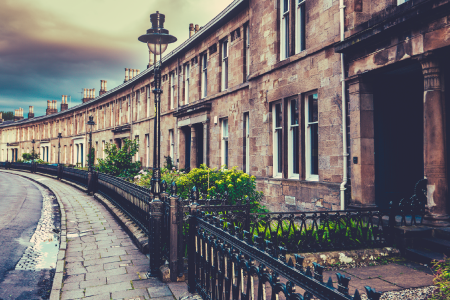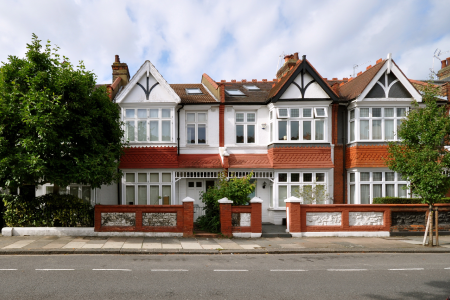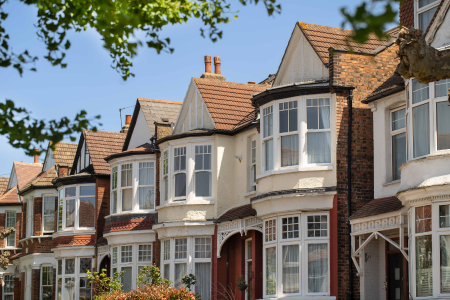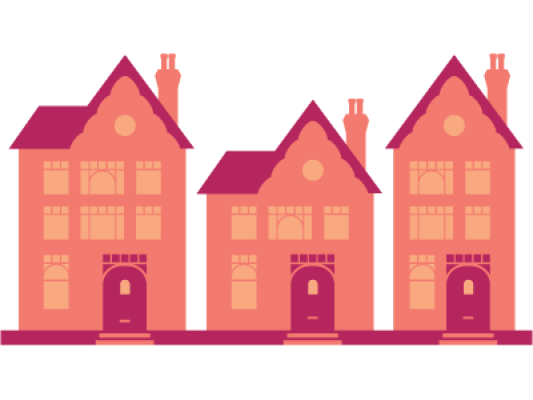Edwardian Properties
Edwardian properties, built between 1901 and 1918, are loved for their spacious rooms and classic style.
They were generally built to a high standard, but due to their age, they can have problems with damp, roofs, and subsidence. A detailed Level 3 Survey is essential for assessing these issues before you buy.
What do Edwardian properties look like?
Edwardian architecture often shows revivalist influences, mixing different styles and designs. You might, for example, see medieval-style exteriors paired with the large, spacious rooms of a Georgian home.
It was common for builders to use a combination of red brick, mock-Tudor timber framing, and decorative panelling on the same house, giving these homes a unique, eclectic feel.
In general, Edwardian homes have a less ornate style compared to the earlier Victorian era. Decorations are still present, but they are often more orderly and less cluttered. Key features include:
- Wider and more spacious hallways, a departure from the narrow Victorian style.
- Large, wide bay fronted windows that let in a lot of natural light.
- Lighter interior colours, as the widespread use of gas and electric lighting meant builders no longer had to worry about soot on the walls.
- Prominent, high-pitched roofs and a more horizontal layout, often without a basement.
- Access to the garden from the main ground floor rooms, which was a new feature for the time. Previously, the ground floor in larger properties was usually the domain of household staff and servants, whereas poorer households had no garden at all.
You can find a large number of these properties in 'garden suburbs' like Dulwich in South-East London, as they were often built in response to the growing demand for suburban living with more outdoor space.



Call or send us a message to request a callback or an email answering your queries about our surveys.
Our UK-based survey team can help you choose the right level of home survey for your property, at no extra charge.
There's no obligation to instruct. We'll make sure you understand your options and provide a free, fixed-fee quote for our best-value survey to meet your needs.
No robots, no call centres. Property challenges solved.
Common problems with Edwardian properties
Edwardian houses have a reputation for being well-built, but most are now over a century old. Period homeowners spend an average of £700 per month on maintenance and repairs (Source: The Independent).
Your surveyor will check for the following common issues:
Roofs and Chimneys
- Original roofs were normally made of slate or clay tiles, which can deteriorate over time. A major issue is when these are replaced with heavier concrete tiles, which can cause the roof to sag.
- Prominent chimneys are also very exposed to the weather, so a surveyor will check the mortar and pots for defects, as well as ensure any disused flues are capped to prevent internal damp.
Walls
- Edwardian walls are usually solid and can suffer from damp if not properly maintained, especially around arches above front entrances.
- Structural issues can arise as a consequence of compromised vertical support: the walls are misaligned because the original design for the kitchen created an unusually tall ground-floor structure that inadequately supported the joists above, causing the first floor to deflect and drop over time.
Damp
- While Edwardian homes generally had a well-installed damp proof course, a key issue is often the ventilation.
- Over the years, air bricks can become covered by soil or paving, which encourages damp to form and can lead to mould. A surveyor will check for proper airflow.
Windows
- Original timber sash and casement windows were often built to help support the weight of the walls and roof.
- If these have been replaced with uPVC windows without additional support, it can lead to sagging or leaking bays and frames.
Floors and Foundations
- Edwardian houses often have shallow foundations, which makes them susceptible to subsidence.
- This is particularly true if the property is on clay soil or if large trees and shrubs are growing close to the walls. Your surveyor will check for signs of movement.
Sub-standard Refurbishment
- As these houses are so old, it is common to find previous maintenance or refurbishment work that was not completed to a professional standard.
- An experienced surveyor will be able to spot these tell-tale signs and advise you on the potential costs to fix them.
What type of survey do you need for Edwardian properties?
Given the number of potential issues with older homes, you need a survey that goes beyond a basic check. A standard mortgage valuation or a Level 2 HomeBuyer Report is often not detailed enough.
For this reason, we highly recommend you get a Level 3 Building Survey (Full Structural Survey). It is a comprehensive, in-depth inspection that looks at every accessible part of the property to identify both major and minor defects.
Your RICS building surveyor can also recommend further specialist checks, such as for timber and damp, if needed.
A specialist Damp & Timber Survey is the only way to get a full and accurate diagnosis.
Our experienced surveyors will identify the problem, determine its cause, and provide a clear plan of action with a fixed quote.
This gives you the power to negotiate or budget for repairs.
Andrew started his career in 2000 working within conveyancing solicitor firms and grew hands-on knowledge of a wide variety of conveyancing challenges and solutions. After helping in excess of 50,000 clients in his career, he uses all this experience within his article writing for SAM, mainstream media and his self published book How to Buy a House Without Killing Anyone.
Caragh is an excellent writer and copy editor of books, news articles and editorials. She has written extensively for SAM for a variety of conveyancing, survey, property law and mortgage-related articles.











